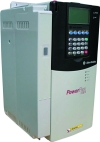

Lifting and hoisting applications can be both simplified and optimised thanks to TorqProve, a new and unique torque control feature on the Allen-Bradley PowerFlex 700 range of AC drives from Rockwell Automation. TorqProve offers both torque control and mechanical brake redundancy, providing users with more on-board functionality, this in turn simplifying applications and reducing installation times and costs.
TorqProve is a product of the PowerFlex 700's flux vector control (FVC) architecture, which provides excellent torque and speed regulation, in combination with fast update times of torque inputs, enabling the drive to cope with occurrences such as torque shocks. It can be used for many kinds of lifting, hoisting or elevator-type applications and simplifies them by automatically coordinating the stopping and starting actions of the PowerFlex 700 drive with the setting and releasing actions of a mechanical brake. This coordination is achieved by checking the current flow through all three motor phases. Only if enough torque is available to assume control of the load does it allow the mechanical brake to be released.
TorqProve works in conjunction with other integrated PowerFlex features. One such feature, Brake Proving, is activated when the speed of the motor reaches zero. The PowerFlex 700 sets the mechanical brake and then monitors motor movement to ensure the brakes ability to hold the load before releasing drive control.
If movement exceeds a set limit, an alarm is set and the drive will start a brake slip procedure. This allows the motor to travel a set distance (brake alarm travel) before a second slip test is performed and this will be repeated continuously until the brake holds and the load stops slipping, or the load reaches the ground. Control of the load is maintained at all times, ensuring that it descends to the ground in a controlled manner, should the mechanical brake fail.
In addition to Brake Proving, the PowerFlex 700 also offers:
Speed Band Limit, a function designed to ensure that, when a certain speed is commanded for the load, it actually travels at that speed.
Float, the condition when the drive is holding the load at zero speed without the need for the brake to engage.
Micro Precision, this allows for slower, more precise (creep speed) operation; and,
Fast Stop, a feature that ensures ramp deceleration time is forced down to just 0,1 second, and that the mechanical brake is applied immediately.
In applications not requiring the Float or Brake Slip functions, the advanced features of PowerFlex 700 allow it to be used in encoder-less hoisting applications whilst still benefiting from the remaining TorqProve features.
The tight integration of torque control and mechanical brake control is just one example of how the advanced features of the PowerFlex range of AC drives from Rockwell Automation can simplify load management and provide cost-effective yet sophisticated motor control in a wide variety of applications.
For more information contact Jeff Sandison, Rockwell Automation, +27 (0) 11 654 9700, [email protected]
| Tel: | +27 11 998 1000 |
| Email: | [email protected] |
| www: | www.rockwellautomation.co.za |
| Articles: | More information and articles about Rockwell Automation |

© Technews Publishing (Pty) Ltd | All Rights Reserved